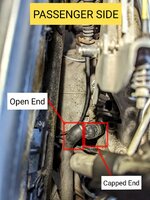Hi all, let me start by saying that this is for a 1994 SL500. I've had better responses and engagement over here versus BenzWorld so hope this is okay.
Short Background: I had a coolant issue a while back that was determined to be due to a leaking heater core. After this was discovered by a local classic Mercedes shop, they recommended blocking off the coolant passages that lead to/from the heater core and so that's what we went ahead and did. Ever since picking up the car, it has been giving me this new rough/surging idle issue. At first, it was once every few minutes... When idling, the car would suddenly cut out and then the revs would surge up to keep it alive. This was back towards the end of last year and I haven't driven the car since.
Present: Now, I get about 1 minute of smooth idle on a cold start and then the car idles rough enough that it's basically undriveable. It also eventually dies after a few minutes. Rather than try to describe the exact symptoms, i've recorded the short video below:
Theory: Being a 1994 car, it suffers from the degrading wire insulation. I have a hunch that while messing around on the backside of the engine where the coolant passages that lead to the heater core are , they probably nudged or bumped into the throttle body cabling and now some wires are touching/interfering with each other. I would think that since I have clean (enough) idle for at least the first minute, there's probably nothing wrong with spark plugs or the associated wiring. Additionally, upper wiring harness has been replaced.
Attempted Solutions:
Has anyone here experienced symptoms similar to those in the video? What would be the best next step? ETA?
Short Background: I had a coolant issue a while back that was determined to be due to a leaking heater core. After this was discovered by a local classic Mercedes shop, they recommended blocking off the coolant passages that lead to/from the heater core and so that's what we went ahead and did. Ever since picking up the car, it has been giving me this new rough/surging idle issue. At first, it was once every few minutes... When idling, the car would suddenly cut out and then the revs would surge up to keep it alive. This was back towards the end of last year and I haven't driven the car since.
Present: Now, I get about 1 minute of smooth idle on a cold start and then the car idles rough enough that it's basically undriveable. It also eventually dies after a few minutes. Rather than try to describe the exact symptoms, i've recorded the short video below:
Theory: Being a 1994 car, it suffers from the degrading wire insulation. I have a hunch that while messing around on the backside of the engine where the coolant passages that lead to the heater core are , they probably nudged or bumped into the throttle body cabling and now some wires are touching/interfering with each other. I would think that since I have clean (enough) idle for at least the first minute, there's probably nothing wrong with spark plugs or the associated wiring. Additionally, upper wiring harness has been replaced.
Attempted Solutions:
- Rotors, Caps, Insulator Shields. There was no history on when these were replaced so I went ahead and took care of this today. None of the original components were all that bad in my opinion (see pics). Unfortunately, no change. Maybe the idle stays smoother for a bit longer, but it still eventually gets bad.
- Vacuum Lines. Admittedly, I don't quite know the best way to test the vacuum system but on a visual look, all seems to be good.
Has anyone here experienced symptoms similar to those in the video? What would be the best next step? ETA?







